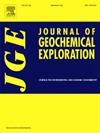中国西南会泽和茅坪MVT铅锌矿床新发现的锗矿物:对锗富集机制和勘探的影响
IF 3.4
2区 地球科学
Q1 GEOCHEMISTRY & GEOPHYSICS
引用次数: 0
摘要
四川-云南-贵州(川滇黔)地区是中国最大的密西西比河谷型(MVT)铅锌锗成矿省,包括巨大的会泽和茅坪矿床。研究表明,Ge 主要以元素置换的形式融入闪锌矿晶格中,而这些矿床中很少有含 Ge 矿物的报道。我们在会泽和茅坪发现了多种颜色的闪锌矿,并在黑色(C1)闪锌矿中进一步发现了含锗矿物。这些含Ge矿物随机分布,矿物形态规则,表明可能是与C1闪锌矿共沉淀,而不是在后期变质和氧化过程中形成的。在会泽 C1 闪锌矿中发现了一种含 Ge 的矿物--方铅矿 (GeO2),这种矿物呈孤立分布或局部与黄铁矿和赤铁矿伴生。在茅坪 C1 闪锌矿中发现了两种含 Ge 的矿物,即布鲁诺盖铁矿(GeFe2O4)和方铁矿(GeO2)。褐铁矿的含量高于绿泥石,通常与黄铁矿伴生,很少与绿泥石伴生。岩石学和元素组成证实,会泽和茅坪的C1闪锌矿是形成最早、形成温度最高的闪锌矿。这表明高温有利于辉石和布氏闪长岩的沉淀。然而,硫和氧富集度的细微差别可能导致会泽和茅坪矿床含 Ge 矿物的出现存在差异。根据川滇黔地区流体混合成矿模式,我们推测含Ge的还原流体与氧化基底盐水在流体混合的初始阶段有利于Ge-氧化物矿物的沉淀。这也与芒硝和布卢诺盖铁矿只与 C1 闪锌矿伴生的发现相一致。随着流体混合的进行,Ge 通过元素置换被纳入闪锌矿晶格。与富含 Ge 的闪锌矿相比,新发现的独立 Ge 矿物(方铅矿和布卢诺盖铁矿)具有更大的经济潜力,从而为 Ge 的富集机制和进一步利用 Ge 资源提供了重要启示。本文章由计算机程序翻译,如有差异,请以英文原文为准。
Newly discovered germanium minerals in Huize and Maoping MVT PbZn deposits in Southwest China: Implications for the germanium enrichment mechanism and exploration
The Sichuan-Yunnan-Guizhou (Chuan-Dian-Qian) region represents the largest Mississippi Valley-type (MVT) Pb-Zn-Ge metallogenic province in China, including giant Huize and Maoping deposits. Research has suggested that Ge is incorporated primarily into the sphalerite lattice in the form of element substitution, and few Ge-bearing minerals have been reported in these deposits. We identified numerous sphalerite colors in Huize and Maoping and further found Ge-bearing minerals in black (C1) sphalerite. These Ge-bearing minerals are randomly distributed and have regular mineral morphologies, suggesting potential co-precipitation with C1 sphalerite rather than formation during later metamorphism and oxidation. One Ge-bearing mineral, argutite (GeO2), is found in Huize C1 sphalerite, which occurs in an isolated distribution or is locally associated with pyrite and hematite. Two Ge-bearing minerals, brunogeierite (GeFe2O4) and argutite (GeO2), are found in the Maoping C1 sphalerite. Brunogeierite is more abundant than argutite and is commonly associated with pyrite and rarely with argutite. The petrography and elemental composition confirmed that the C1 sphalerite in Huize and Maoping is the earliest formed sphalerite with the highest formation temperature. This suggests that high temperatures favor the precipitation of argutite and brunogeierite. However, slight variations in sulfur and oxygen fugacity may have resulted in discrepancies in the occurrence of Ge-bearing minerals between the Huize and Maoping deposits. According to the fluid mixing metallogenic model in the Chuan–Dian–Qian region, we posit that Ge-oxide mineral precipitation benefited from the initial stage of fluid mixing between Ge-bearing reduced fluid and oxidized basinal brine. This is also consistent with the findings that argutite and brunogeierite are exclusively associated with C1 sphalerite. As fluid mixing progresses, Ge is incorporated into the sphalerite lattice via element substitution. The newly discovered independent Ge minerals (argutite and brunogeierite) present greater economic potential than Ge-rich sphalerite does, thereby offering significant insights into the enrichment mechanism of Ge and the further utilization of Ge resources.
求助全文
通过发布文献求助,成功后即可免费获取论文全文。
去求助
来源期刊

Journal of Geochemical Exploration
地学-地球化学与地球物理
CiteScore
7.40
自引率
7.70%
发文量
148
审稿时长
8.1 months
期刊介绍:
Journal of Geochemical Exploration is mostly dedicated to publication of original studies in exploration and environmental geochemistry and related topics.
Contributions considered of prevalent interest for the journal include researches based on the application of innovative methods to:
define the genesis and the evolution of mineral deposits including transfer of elements in large-scale mineralized areas.
analyze complex systems at the boundaries between bio-geochemistry, metal transport and mineral accumulation.
evaluate effects of historical mining activities on the surface environment.
trace pollutant sources and define their fate and transport models in the near-surface and surface environments involving solid, fluid and aerial matrices.
assess and quantify natural and technogenic radioactivity in the environment.
determine geochemical anomalies and set baseline reference values using compositional data analysis, multivariate statistics and geo-spatial analysis.
assess the impacts of anthropogenic contamination on ecosystems and human health at local and regional scale to prioritize and classify risks through deterministic and stochastic approaches.
Papers dedicated to the presentation of newly developed methods in analytical geochemistry to be applied in the field or in laboratory are also within the topics of interest for the journal.
 求助内容:
求助内容: 应助结果提醒方式:
应助结果提醒方式:


